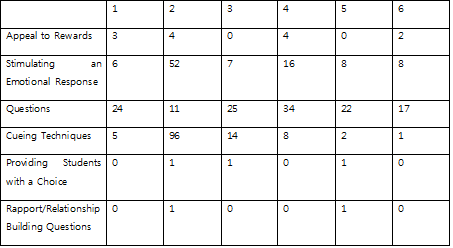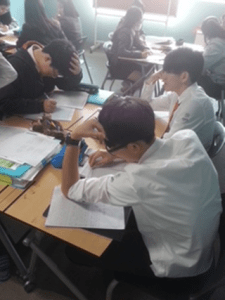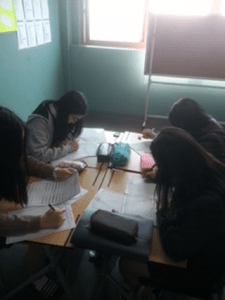Christopher L. Miller
A Challenge Embraced
A few years ago Dr. Thomas Farrell gave a plenary talk at the KOTESOL International Conference. Among the many wonderful parts of the lecture, Dr. Farrell urged the attendees to “at least once” record your teaching performance. Furthermore, he promised that after adopting a reflective orientation, the classroom would never “be a boring place.” His words had a positive effect on me and stimulated me to attempt to engage in more structured forms of reflective practice.
I decided to record myself six times over the course of a single semester, and essentially attempt to note what, if any, changes might result in my practice from engaging in such somewhat intensive forms of analysis and reflection on my personal practice.
I started this project with limited research tools and was primarily motivated by curiosity and a belief that such sustained reflective practices would have a beneficial impact on my teaching practice. This article is an attempt to convey the effect of engaging in deep analysis of one’s teaching performance. First, I will detail my basic methods of inquiry, the context in which I conducted this minor action research project and discuss the results both quantitative and qualitative that emerged from this project.
Two key concepts from the literature about reflective practice helped orient me during this project. First, self-observation (SO), which Richards defines as “the observation, evaluation, and management of one’s one behavior” (Richards, 1990 in Farrell, 2014). I especially liked the three aspects of SO, so succinctly delineated by Richards. Certainly earlier in my career, I would often get “stuck” in the observation phase, and somewhat haphazardly proceed to attempt to implement whatever insights emerged from the process of SO. The terms evaluation and management provided me with a framework to sustain the insights which frequently emerged through engaging in SO. The other concept, critical incidents (CI), provided a focus when analyzing both my experience and the transcripts of my recorded teaching performance. Brookfield defines a critical incident as “any unplanned and unanticipated event that occurs during class, outside class, or during a teacher’s career, but is “vividly remembered” (Brookfield, 1990 in Farrell, 2014).
With these two concepts in mind, I jumped in and began recording my lessons and transcribing them manually. I aimed to record one lesson per week, but due to shifts in school schedule related to holidays and various school events, that was rather difficult to maintain. When determining the number of lessons to record, I decided on six, with the primary aim being to keep the project manageable and able to be completed within a full semester (fall 2016).
My Teaching Context
I currently work at a foreign language high school in South Korea. I teach both first and second grade high school classes. Students have class with me twice a week and each class is fifty minutes long. Class size is approximately 12-13 students. During this semester my primary teaching responsibilities included persuasive writing and presentation skills. My students could be characterized as having the “3 Ss.” They are highly smart, the school frequently recruits from the top 1% of middle school students, many students have the ambition of attending one the three major SKY universities (i.e. the equivalent of the ivy league for South Korea); and they are stressed; students typically stay in the school until at least 10:00 p.m. and then return to their dorms or houses for further study, not to mention the challenges which come from striving to get admitted into elite universities.
Outcomes
Once I began audio recording and transcribing lessons, I felt some degree of objective data might help me gain a deeper appreciation of my lessons. Thus, I decided to engage in a series of frequency counts (Perry Jr., 2011). As a point of reference I used a framework from Helgesen and Kelly (2015) for making more “brain-friendly lessons” and added a few additional items which were relevant for my teaching background and questions and even concerns I had about my practice, such as do I appeal to rewards too much in my lessons? Given space constraints I’m not going to explain in detail about operational definitions for each term; here are the results of the frequency counts:

The frequency counts helped answer a few questions I had in my head about my teaching. I felt relieved that I was not overusing extrinsic motivators and that I was able to get students to have an emotional reaction during the class.
However, there were other issues which I felt I would eventually have to confront about my teaching practice. Why did students have so little choice in my lessons? How could I have more positive (and always professional) interpersonal interactions with my students during lessons? I have not yet systematically analyzed these two concerns to date, though there is one concrete modification I have made as it pertains to student choice. When practicing vocabulary through speaking activities (such as those found in Jackie Bolen’s extremely useful guidebooks)
I now provide students with an alternative activity and students as a class take a vote on which activity they would prefer. I also now make it a point to engage students in small talk before class begins, as well as have a small (and optional) “puzzle like” activity on the powerpoint or white board which students are free to complete and tell me the answer to prior to the start of class.
CIA
If someone asked me why they should record their lessons and engage in more systematic forms of SO, I would reply “CIA.” This is an acronym for some of the benefits which can emerge from deeply reflecting on one’s practice. C for change, I for insight, and A for awareness.
Change
There were various small changes that I made in my lessons after recording and transcribing them. I can’t say that these necessarily led to student learning gains, however, I feel it made my presentation of the material clearer. For instance, while training students on how to make optimal use of their voice during presentations, I was searching for a good illustration for an appropriate opportunity to use the “stretching technique” (as illustrated in Speaking of Speech). One example, which I provided was when introducing a guest, such as on a late night talk show. Students were a little confused. When I was explaining this, a student commented “oh like in UFC.” After hearing this, I was able to add another illustration for when students might consider stretching their voice during a presentation. It is unlikely I would have maintained awareness of this interaction/ CI had I not recorded, transcribed, and reflected on my lessons.
Again in the Speaking of Speech text, Harrington, et al. provide three voice modulation techniques (stress, stretch, pause). While analyzing my recordings for a lesson in which I taught this framework, it became apparent that I could present these three concepts using a mnemonic acronym. Thus, instead of merely stating “stress, stretch, pause” and briefly explaining the concepts before students practiced and applied the skills, I provided students with the mnemonic PaSS, this may seem rather simple and in many ways it is, however, it has multiple benefits: it helps to aid students in concept label retention, it provides students with a cue to stimulate them to actively recall the framework under consideration, and it streamlines the amount of time needed for the teacher to check basic comprehension. These kinds of insights and microshifts often seemed to emerge naturally from engaging in a more systematized form of reflective practice.
Insight
I must state at the onset that what follows is a bit of speculation. I felt that this form of SO helped make me more sensitive to the types of motivations students had and the pressures they had to deal with as learners in a highly competitive environment. I will provide one illustration. One student was extremely friendly with me and would often engage me in conversation before class began. I came to learn that the student had studied in an American school previously. However, this student was typically receiving average marks (relative to his/her classmates) in my class, not necessarily struggling, but not at the top of the class either. As I was transcribing these lessons, I began to wonder if the student was attempting (consciously or unconsciously) to curry favor with me? Was it to simply practice English? Was the student’s behavior merely a consequence of the student’s personality? I do not know, I personally feel it is not appropriate for me to inquire too deeply into such issues. However, through a deep reflection on the artifacts of my practice, I was able to further appreciate the multiple factors which influence the behaviors and choices of my learners.
Awareness
This SO project provided me with a much deeper awareness of several tendencies I have as a teacher. For example, there were several times I would sing (English) lyrics to a K-pop song during class. It would often lead to an emotional response, such as laughter from my students but I did notice that I may have overused this simple trick to help maintain student awareness. Also, I did have moments of sarcasm, for example in the 5th transcribed lesson I stated: “alright, let’s do a quick review question here, an exciting review question, now we’re going to talk about four different hook types today.” Ultimately, I am dealing with learners who are primarily extrinsically motivated and at times clearly display signs of burnout both with education in general and English particularly. That will affect how I interact with students as a teacher, some sarcasm at times will probably be unavoidable, but deeper awareness of the tendency can help me to reduce the frequency.
Also I noticed that I would go off on minor tangents while providing brief lectures or explanations and directions for learning activities to students. For instance, while providing a summary about aspects on an essay map during the 5th transcribed lesson I said the following “…[essay] map, that represents one idea for your body paragraphs alright, so be aware of it, I think you already know about it, I just want to remind you of it, we’ll look at some examples, I don’t think it’s a big deal, now we’re going to look at this introduction, number one…”
There are several issues with this utterance. First, shouldn’t students be the one’s actively demonstrating their comprehension of the material—why am I retelling it to students? (I have since found Rick Wormeli’s excellent book Summarization in any Subject to be a great resource for supplying teaching ideas to get students to be more active during review activities). Also, there is a lot of unnecessary language in this statement. What I am really doing is vocalizing and thereby sharing my teacher cognition with students. In other words, as a professional I am thinking out loud. Yes, I feel I don’t need to review this material with students too deeply (because I felt students had a sufficient level of comprehension of the material). However, I do feel a brief comprehension check was warranted. The belief could be arguable, but also seems reasonable enough. Though reflecting on it, I now wonder, why am I saying this to students—why do they need to know that I don’t think it is a big deal for them to review more? If I feel a brief review is warranted, in whatever format, then I should commence with the review activity rather than explain the processes that led me to believe that this was the appropriate course of action at this particular time. Ultimately such tendencies add to the extraneous cognitive load students must manage during class time (Clark, Ngyuen, Sweller, 2005).
Conclusion
Engaging in SO provides teachers with a tool to gain awareness of their professional tendencies and make principled adjustments to their practice. SO has helped me to mitigate questionable practices and resolved lingering questions about the choices I make in the classroom. It is difficult to quantify both how RP improves teacher performance and what effect this has, if any, on student outcomes. However, I can point to one form of objective data. After my first year at my current school, student evaluations (of my teaching performance) hovered around the 4.0 mark. Now, as I am finishing my 4th year at the same school, my student evaluations average at 4.7. Thus, it seems fair to claim that my teaching has improved (even if only slightly) over the last three years. I’m confident SO and other forms of RP have played a significant role in that shift.
Have you ever engaged in any form of SO? What benefits emerged for you?
References
- Bolen, J. and Booker-Smith J. (2016). 101 ESL activities for teenagers and adults. [Self-Published].
- Brooksfield, S. (1990) The skillful teacher. San Francisco, CA: Jossey Bass.
- Clark, R.C. Ngyuen, F., and Sweller, J. (2005). Efficiency in learning: evidence-based auidelines to manage cognitive load. San Francisco: Pfeiffer.
- Farrell, T.S.C. (2015) Promoting teacher reflection in second language education: A framework for TESOL professionals. New York: Routledge.
- Harrington, D. and LeBeau, C. (2009). Speaking of speech: basic presentation skills for beginners. Tokyo: Macmillan.
- Helgesen, M. and Kelly, C. (2015). Do it yourself NeuroELT: Ways to make your textbook more brain-friendly.
- SPELT Quarterly 30 (3).
- Perry, F.L (2011). Research in applied linguistics: Becoming a discerning consumer. New York: Routledge.
- Richards, J. (1990) Beyond training: approaches to teacher education I language teaching. Lanaguage Teacher 14: 3-8.
- Wormeli, R. (2009). Summarization in Any subject: 50 techniques to improve student learning. Alexandria, VA.







